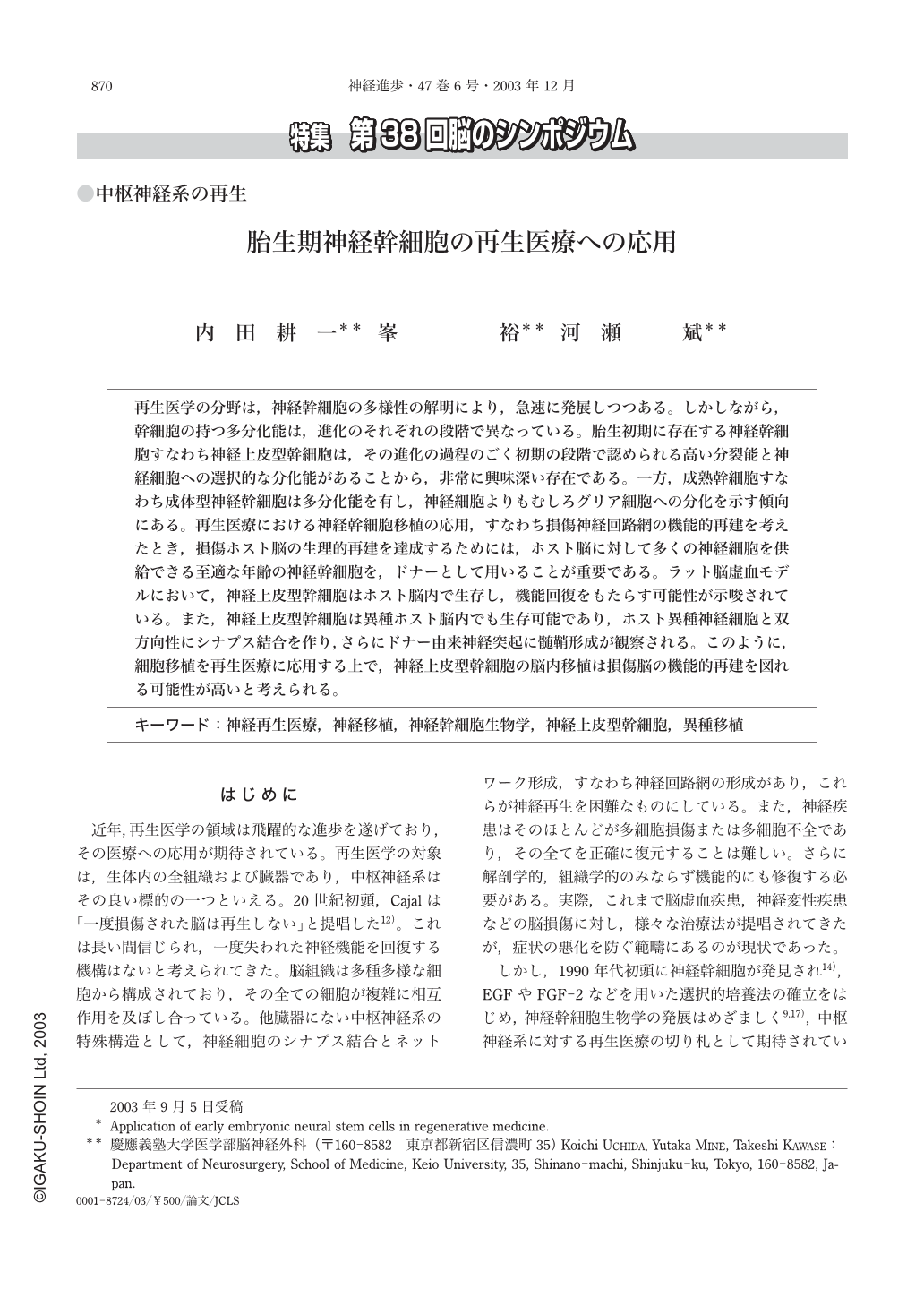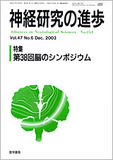Japanese
English
- 有料閲覧
- Abstract 文献概要
- 1ページ目 Look Inside
再生医学の分野は,神経幹細胞の多様性の解明により,急速に発展しつつある。しかしながら,幹細胞の持つ多分化能は,進化のそれぞれの段階で異なっている。胎生初期に存在する神経幹細胞すなわち神経上皮型幹細胞は,その進化の過程のごく初期の段階で認められる高い分裂能と神経細胞への選択的な分化能があることから,非常に興味深い存在である。一方,成熟幹細胞すなわち成体型神経幹細胞は多分化能を有し,神経細胞よりもむしろグリア細胞への分化を示す傾向にある。再生医療における神経幹細胞移植の応用,すなわち損傷神経回路網の機能的再建を考えたとき,損傷ホスト脳の生理的再建を達成するためには,ホスト脳に対して多くの神経細胞を供給できる至適な年齢の神経幹細胞を,ドナーとして用いることが重要である。ラット脳虚血モデルにおいて,神経上皮型幹細胞はホスト脳内で生存し,機能回復をもたらす可能性が示唆されている。また,神経上皮型幹細胞は異種ホスト脳内でも生存可能であり,ホスト異種神経細胞と双方向性にシナプス結合を作り,さらにドナー由来神経突起に髄鞘形成が観察される。このように,細胞移植を再生医療に応用する上で,神経上皮型幹細胞の脳内移植は損傷脳の機能的再建を図れる可能性が高いと考えられる。
はじめに
近年,再生医学の領域は飛躍的な進歩を遂げており,その医療への応用が期待されている。再生医学の対象は,生体内の全組織および臓器であり,中枢神経系はその良い標的の一つといえる。20世紀初頭,Cajalは「一度損傷された脳は再生しない」と提唱した12)。これは長い間信じられ,一度失われた神経機能を回復する機構はないと考えられてきた。脳組織は多種多様な細胞から構成されており,その全ての細胞が複雑に相互作用を及ぼし合っている。他臓器にない中枢神経系の特殊構造として,神経細胞のシナプス結合とネットワーク形成,すなわち神経回路網の形成があり,これらが神経再生を困難なものにしている。また,神経疾患はそのほとんどが多細胞損傷または多細胞不全であり,その全てを正確に復元することは難しい。さらに解剖学的,組織学的のみならず機能的にも修復する必要がある。実際,これまで脳虚血疾患,神経変性疾患などの脳損傷に対し,様々な治療法が提唱されてきたが,症状の悪化を防ぐ範疇にあるのが現状であった。
しかし,1990年代初頭に神経幹細胞が発見され14),EGFやFGF-2などを用いた選択的培養法の確立をはじめ,神経幹細胞生物学の発展はめざましく9, 17),中枢神経系に対する再生医療の切り札として期待されている。しかし,その特徴をいかに活かして再生医療に応用していくかが課題となってきている。
本稿では神経幹細胞に関する最近の知見と再生医療への応用の可能性について,筆者らの取り組みを紹介して解説したい。
The field of regenerative medicine is developing rapidly based on the expanding understanding of the pluripotentiality of neural stem cells. However, the true multipotency of the stem cells differs with their stage of development. Early embryonic neural stem cells,i.e., neuroepithelial stem cells,are of particular interest both because of their high mitotic rate and their ability to differentiate selectively into neuronal cells during the very early stage of their development. On the other hand, mature stem cells, i.e., adult type neural stem cells, while having multipotency, tend to show glial differentiation rather than neuronal. When considering the application of neural stem cell transplantation in regenerative medicine, namely the functional repair of damaged or compromised neuronal circuitry, it is thus important to use donor neural stem cells of an appropriate age to ensure a good supply of neurons to the host brain, thus achieving the desired physiological repair of the damaged host brain. In the ischemic rat model, neuroepithelial stem cells have been shown to be capable of survival in the host brain with functional recovery of the subjects. Neuroepithelial stem cells are also able to survive in the xenogeneic host brain, and form myelinated axons with synapses both to and from the host neurons. Neuroepithelial stem cells are therefore highly potential candidates for use in cell transplantation in regenerative medicine to achieve the functional repair of the damaged brain.

Copyright © 2003, Igaku-Shoin Ltd. All rights reserved.


